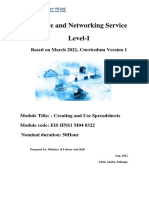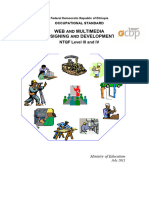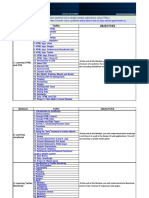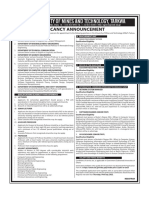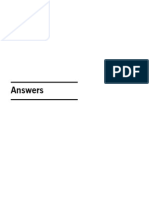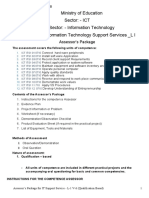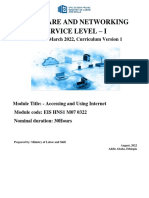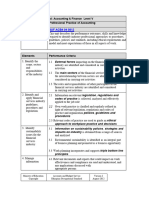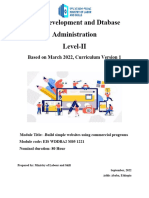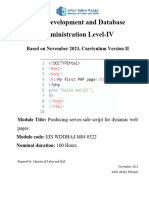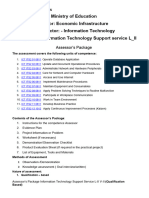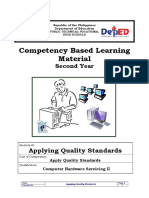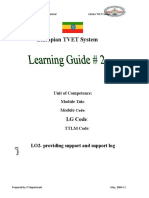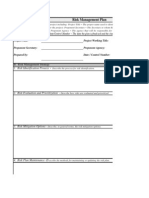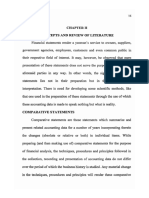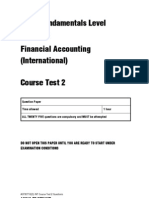Learner Guide
Learner Guide
Uploaded by
narasi64Copyright:
Available Formats
Learner Guide
Learner Guide
Uploaded by
narasi64Original Title
Copyright
Available Formats
Share this document
Did you find this document useful?
Is this content inappropriate?
Copyright:
Available Formats
Learner Guide
Learner Guide
Uploaded by
narasi64Copyright:
Available Formats
Working together for a skilled tomorrow
Learning Materials
Unit Standard Title:
Interpret basic financial statements
Unit Standard No:
10388
Unit Standard Credits:
NQF Level:
Learner Guide
This outcomes-based learning material was
developed by
INHLE Business Solutions
and reviewed by
Metropolitan Life and
Momentum
with funding from INSETA in October 2003.
The material is generic in nature.
Its purpose is to serve as a guide for the further development
and customization of company-specific, learner-specific
and situation-specific learning interventions.
Disclaimer:
Whilst every effort has been made to ensure that the learning material is accurate, INSETA takes no responsibility
for any loss or damage suffered by any person as a result of the reliance upon the information contained herein.
INSMAT final materials
31/10/03
Unit Standard No.10388
Page 2
Table of Contents
INTRODUCTION AND OVERVIEW OF THE MODULE...................................................................5
THE PURPOSE OF THIS MODULE.......................................................................................................5
THE TEACHING STRATEGY..................................................................................................................5
CRITICAL CROSS FIELD AND DEVELOPMENTAL OUTCOMES....................................................................6
MASTERING THE STUDY MATERIAL..........................................................................................................6
SPECIFIC OUTCOME 1.........................................................................................................................8
ANALYSE THE BASIC ELEMENTS OF AN INCOME AND EXPENDITURE STATEMENT...........8
INCOME AND EXPENDITURE STATEMENTS..................................................................................9
1.1.
1.2.
1.3.
INCOME........................................................................................................................................9
EXPENDITURE.............................................................................................................................9
THE PURPOSE OF AN INCOME AND EXPENDITURE STATEMENT....................................9
CASE STUDY 1.1: THE INCOME AND EXPENDITURE STATEMENT OF A PRIVATE
INDIVIDUAL..........................................................................................................................................10
EXERCISE 1.1.........................................................................................................................................11
CASE STUDY 1.2: THE INCOME AND EXPENDITURE STATEMENT OF A COMPANY.........12
SOURCES OF INCOME AND EXPENDITURE.................................................................................14
FINANCIAL VIABILITY.......................................................................................................................21
SPECIFIC OUTCOME 2.......................................................................................................................29
ANALYSE THE BASIC ELEMENTS OF A BALANCE SHEET..........................................................29
2.1. THE PURPOSE OF A BALANCE SHEET...............................................................................................30
COMMON ELEMENTS OF A BALANCE SHEET............................................................................30
THE CAPITAL EMPLOYED SECTION.........................................................................................................30
EMPLOYMENT OF CAPITAL SECTION......................................................................................................31
NOTES TO THE BALANCE SHEET............................................................................................................31
2.2 THE ANALYSIS OF BALANCE SHEETS................................................................................................34
2.3. THE CONCEPT OF AN ASSET..............................................................................................................37
2.4. THE CONCEPT OF A LIABILITY..........................................................................................................39
SPECIFIC OUTCOME 3.......................................................................................................................49
COMPILE A PERSONAL ASSETS AND LIABILITIES STATEMENT...............................................49
3.1. COMPILING A PERSONAL ASSETS AND LIABILITIES STATEMENT................................50
EXERCISE 3.1............................................................................................................................................50
3.2. SITUATIONS WHERE AN ASSETS AND LIABILITIES STATEMENT ARE REQUIRED..................................52
THE ADVANTAGES OF KEEPING SUCH RECORDS.......................................................................................52
SPECIFIC OUTCOME 4.......................................................................................................................56
USING THE EVIDENCE IN FINANCIAL STATEMENTS TO MAKE A FINANCIAL DECISION..56
CASE STUDY 4.1. BAGS OF HAMMERS (PTY) LTD ..................................................................................57
CASH FLOW AND LIQUIDITY.....................................................................................................................66
INSMAT final materials
31/10/03
Unit Standard No.10388
Page 3
Introduction and overview of the module
The purpose of this module
Welcome to the Unit Standard: Interpreting Basic Financial Statements with INSQA
The purpose of the module is to provide learners with knowledge and skills to enable
them to interpret basic financial statements of companies.
The teaching strategy
The focus of our teaching role is on facilitating your learning experiences toward
achieving specific assessment criteria. Furthermore, for each of the topics that
comprise this module, the learning experiences are designed with the aim of enabling
you to master the learning content at a predetermined competence level.
LEARNING OUTCOMES, ASSESSMENT CRITERIA AND LEVELS OF MASTERY
Each topic dealt with in this module contains a statement of the learning outcomes
that we wish to accomplish for the particular topic. In broad terms these tell you about
the knowledge and skills we expect you to have mastered by the time you have
completed your study of each topic. The assessment criteria indicate a required end
result, which is what you should be able to do once you have completed the study
unit. The formulated assessment criteria are based on various levels of mastery that
you are required to achieve when mastering the study material. The required levels
of mastery for this module vary from knowledge and comprehension to the
integration of knowledge under given circumstances. The following levels of mastery
are distinguished for the purposes of this module (Please note that these levels are
not exact duplications of those provided by SAQA, but summaries thereof.):
Level 1: Knowledge and comprehension
This calls for a knowledge and understanding of facts, methods, processes and
structures and an ability to list and explain them. It involves memorising as well as an
awareness, immediate discovery, recall or recognition of relevant information in
various forms. A limited degree of interpretation is required.
Level 2: Application
This calls for a knowledge and understanding of the background and of related topics
and the ability to apply rules, principles, techniques and methods to a problem in
order to find a solution based on the information that is provided.
Level 3:Integration
This calls for a full factual knowledge of the topic, of the background and of related
topics and an ability to carry out integration functions, such as analysis,
interpretation, synthesis and evaluation. It includes the application of multidisciplinary knowledge and problem solving in cases where there are various
acceptable solutions. In this sense it constitutes creative thinking, comprising fluency,
flexibility, originality, critical awareness and independent thought.
The module is aimed at critical cross-field and development outcomes that are the
objectives of the module. They aim to facilitate your mastery of the subject matter by
applying a cross-section of skills and assist your development with defined
outcomes.
INSMAT final materials
31/10/03
Unit Standard No.10388
Page 4
Critical Cross Field and Developmental Outcomes
You are able to identify, solve problems and make decisions based on the information
in basic financial statements.
You are able to communicate effectively using visual, mathematics and language
skills in the modes of oral and written presentation when evaluating the strengths and
weaknesses of an entity.
You are able to organise and manage yourself effectively compiling a personal assets
and liabilities statement.
Mastering the study material
This module requires careful and dedicated study. You must become proficient in the
interpretation and analysis of basic financial statements, which requires diligence and
thoroughness.
INSMAT final materials
31/10/03
Unit Standard No.10388
Page 5
Specific Outcomes
This module is made up of four specific outcomes, which are further broken out into
assessment criteria. The four specific outcomes are:
SO1: Analyse the basic elements of an income
and expenditure statement
SO2: Analyse the basic elements of a balance
sheet
SO3: Compile a personal assets and liabilities
statement
SO4: Use the evidence in financial statements to
make a financial decision
Exercise questions are included as you progress through the Specific Outcome.
A Self-Assessment questionnaire will be given to conclude the Specific Outcome.
INSMAT final materials
31/10/03
Unit Standard No.10388
Page 6
Specific Outcome 1
Analyse the basic elements of an income and expenditure
statement
Learning outcomes
By the end of this module you should be able to do, define or provide the following;
1. The purposes of an income and expenditure statement are explained and an
indication is given of how often these statements are required for two case
studies.
2. Sources of income and expenditure are identified for three different types of
financial statements.
3. Sources of income and expenditure are explained with reference to an
income and expenditure statement.
4. Three income and expenditure statements are examined and evaluated in
terms of financial viability of the enterprise.
INSMAT final materials
31/10/03
Unit Standard No.10388
Page 7
Income and expenditure statements
Income and expenditure statements are a report of the money you made and the
money that you spent during a period of time. You can do a statement for a month, a
quarter or a year or any time period.
Definitions
1.1.
Income
For the purposes of this module, income is defined as money that has been made
within the time period of the statement. It is an important accounting concept to
correctly account for income within the time period of the financial statement. This
means that you should include in your income calculation money that you have made
but not yet received. For example, if you were a trader and sold goods but had not
yet received the money (because you had given your customer some credit terms)
you should nonetheless include the sale as income for the period, even if the
customer only pays you after the end of the period.
1.2.
Expenditure
For the purposes of this module, expenditure is defined as the costs that have been
incurred within the time period of the statement. As with the concept of income, you
should accrue for expenditures incurred within the time-period even if you have not
paid for them. If, for example, you were doing a household income and expenditure
statement for the end of September and you had not received your water and lights
bill nor paid it for September, you should nonetheless include it (or a reasonable
estimate) in the income and expenditure statement for September. This ensures that
you have an accurate statement of the real expenditures incurred within the period.
At the end of the income and expenditure statement, you subtract Expenditure from
Income and the remaining portion is what an enterprise would call Profit. If
expenditures were more than Income, the negative difference is what an enterprise
would call Loss.
1.3.
The purpose of an Income and Expenditure Statement
The purpose of an Income and Expenditure Statement is to clearly show how
much money was made and how much was spent within a given time period.
Obviously, it is much better to have money left over when you subtract Expenditure
from Income. Users of financial statements find them to be an endless mine of
information on which they can base realistic business and economic decisions.
Legislation requires that when doing the financial statements of a company, certain
specific requirements regarding the disclosure of information must be met. According
to the Companies Act 61 of 1973 a companys financial statements have to be drawn
up in accordance with generally accepted accounting practice (GAAP) as well as the
specific requirements of schedule 4. In this module you are not expected to know the
specific requirements but an awareness of the common elements will assist you in
understanding financial statements.
INSMAT final materials
31/10/03
Unit Standard No.10388
Page 8
CASE STUDY 1.1: The Income and Expenditure Statement of a private
individual.
Sunny is a private individual who works in an office as a consultant. She wishes to
obtain a loan from Big Sharks bank to finance the purchase of a new car. Big Sharks
has requested that Sunny produce an income and expenditure statement to
demonstrate to them that she has the income necessary to meet the repayments of
the loan which amount to R1000 per month.
Sunny has drawn up the following statement:
Statement of Income and Expenditure for Sunny
For the period 1 Jan 2003 to 31 Dec 2003
Income
Annual Salary after Taxation
Expenditure
Bond Repayments on House
Food
Clothing
Water & Lights
Telephone
Entertainment
Funds Remaining
R
100,000
R30, 000
R20, 000
R5, 000
R5, 000
R2, 000
R4, 000
R26, 000
From this statement, Big Sharks bank can easily see that Sunny has sufficient money
left over after her expenses have been deducted to meet the loan repayments. (12 x
R1, 000 = R12, 000 per annum)
Normally an individual is only required to produce a statement like this either for, as
in the case study, a bank loan or sometimes when completing a tax return. There is
no requirement for an individual to produce the statement on an annual basis as
required for companies by the Companies Act of 1973.
It is, however, a good personal management tool and a wise person would compile
such a statement and keep a good eye on it on a regular basis.
INSMAT final materials
31/10/03
Unit Standard No.10388
Page 9
Exercise 1.1
State how often Sunny in the case study above has to produce an income and
expenditure account
INSMAT final materials
31/10/03
Unit Standard No.10388
Page 10
Case Study 1.2: The Income and Expenditure Statement of a company
FLAVAZZ Ltd
Flavazz Ltd produces the chemical flavours used to flavour foodstuffs. They have
been in operation since 1958 and continue to run as a family owned private business.
Because they are incorporated as a company, they are required to produce Annual
Financial Statements. Interested parties, such as the owners of the company, clients
and suppliers who do business with them and SARS, the Receiver of Revenue, may
review these financial statements and make decisions on the results accordingly.
Flavazz Ltd
Statement of Income and Expenditure
For the period 1 September 2002 to 31 October 2003
Sales
Less: Purchases
Gross Profit
Less: Expenditure
Accounting Fees
Cleaning Materials
Computer Expenses
Motor & Travel
Rental of Factory Premises
Stationery & Office Expenses
Staff Refreshments
Salaries
Staff Training
UIF
Workmans Compensation
Net Profit
R
1,500,000
700,000
800,000
1,200
5,000
20,000
50,000
200,000
20,000
10,000
400,000
1,000
4,000
4,000
84,800
The Accountant for Flavazz Ltd is responsible for ensuring that the figures contained
in the Statement of Income and Expenditure are accurate and reflect a true position
of the finances of the company. The Accountant must also produce these financial
statements annually after the year end (which in Flavazz Ltds case is the 31
October)
INSMAT final materials
31/10/03
Unit Standard No.10388
Page 11
Exercise 1.1
Indicate how often income and expenditure statements are required for companies
INSMAT final materials
31/10/03
Unit Standard No.10388
Page 12
Sources of income and expenditure
Income and expenditure sources are as varied as the types of industries and
businesses in operation. People too, derive their income and spend their money in all
possible ways. The ways of income are many and varied: it is your task to identify
these in the financial statements and be able to recognise the income from the costs.
CASE STUDY 1.3: Teddys Toys Inc
Teddys Toys has a shop in a shopping mall. They sell toys, educational devices and
childrens party tricks. Teddy, the proprietor, has had the following statement of
income and expenditure prepared for tax purposes.
Teddys Toys Inc
Statement of Income and Expenditure
For the period 1 March 2002 to 28 February 2003
Sales
Cost of Sales
Opening Stock
Add: Purchases
Less: Closing Stock
Gross Profit
Less: Expenditure
Accounting Fees
Cleaning Materials
Computer Expenses
Motor & Travel
Rental of Retail Premises
Stationery & Office Expenses
Salaries
UIF
Workmans Compensation
Net Profit
R
150,000
50,000
5,000
51,500
6,500
100,000
1,200
5,000
2,000
5,000
20,000
2,000
20,000
450
200
44,150
In the case study above, expenditures incurred in generating sales include the
purchases of goods for resale, called purchases. Note that purchases in accounting
terms have a specific meaning: it means the costs incurred in acquiring goods for
resale. It does not include other costs, such as the ones listed in the Expenditure
section. These must be disclosed separately.
The Cost of Sales calculation, which is Opening Stock Add Purchases Less Closing
Stock, is calculated and subtracted from sales to give Gross Profit. Gross Profit is an
indication of the profitability of operations, not including other expenses and
overheads. In a retail environment, for example, as the business purchases goods for
resale, you would not include the cost of rental of premises. This is because it is
counter-intuitive to directly attribute the cost of renting the shop to any given sale. It is
therefore more logical to show rental of premises in the Expenditures section. This is
not a hard-and-fast rule though: depending on the operating environment and the
type of costing that is being done, in some cases it is possible to apportion a rental
overhead to the cost of production.
INSMAT final materials
31/10/03
Unit Standard No.10388
Page 13
Exercise 1.2
Identify the sources of income and expenditure for Teddys Toys Inc.
INSMAT final materials
31/10/03
Unit Standard No.10388
Page 14
Case Study 1.4: Ferrys Fast Foods
Ferrys fast foods is a vendor of burgers, fries, chicken and cold drinks. They cater
mainly to the lunchtime crowd in the office park where their outlet is situated.
Below is a copy of Ferrys Fast Foods Income Statement prepared by their
accountant for tax purposes.
Ferrys Fast Foods
Statement of Income and Expenditure
For the period 1 March 2002 to 28 February 2003
Sales
Add: Purchases
Gross Profit
R
350, 000
80, 000
270, 000
Less: Expenditure
Accounting Fees
Cleaning Materials
Motor & Travel
Rental of Retail Premises
Salaries
UIF
Workmans Compensation
Net Profit
1, 500
7, 000
4, 000
40, 000
80, 000
450
200
136, 850
INSMAT final materials
31/10/03
Unit Standard No.10388
Page 15
Exercise 1.3
Identify the sources of income and expenditure for Ferrys Fast Foods
INSMAT final materials
31/10/03
Unit Standard No.10388
Page 16
Case Study 1.5: Risk Insurance Consultants
Risk Insurance Consultants cater to the short-term insurance market. They sell
policies for medical, motor and household insurance. They have an office in a citycentre office block.
Risk Insurance Consultants
Statement of Income and Expenditure
For the period 1 March 2002 to 28 February 2003
Commission Received
R
350, 000
Less: Expenditure
Accounting Fees
Computer Expenses
Depreciation
Motor & Travel
Rental of Office Premises
Salaries
Telephone & Internet
UIF
Workmans Compensation
Net Loss
1, 500
20, 000
3, 000
24, 000
50, 000
200, 000
40, 000
3, 500
3, 500
(6, 500)
INSMAT final materials
31/10/03
Unit Standard No.10388
Page 17
Exercise 1.4
Firstly, identify the sources of income and expenditure for Risk Insurance Consultants
and when you have identified these sources provide and explanation of each of these
sources that you have identified.
INSMAT final materials
31/10/03
Unit Standard No.10388
1. Identify
Page 18
the Sources of Income and Expenditure
INSMAT final materials
31/10/03
Unit Standard No.10388
Page 19
Now explain these sources of Income and Expenditure
INSMAT final materials
31/10/03
Unit Standard No.10388
Page 20
Financial Viability
The concept of the going concern is an important accounting concept. Financial
Statements are usually prepared with the assumption that the enterprise is a going
concern, without evidence to the contrary. This assumption implies that the business
will continue its operations for the foreseeable future.
Financial viability implies that:
The concern will continue its operations in the foreseeable future.
The enterprise is sufficiently profitable (or will be in the future) to continue its
operations.
There is inherent worth in continuing operations. This is related to the concept of
ongoing profits. It is important to note that sometimes companies do not make a
profit every year especially in the first few years of operations. A
businessperson would examine financial statements for their financial viability
and also take a view on the inherent worth. A full assessment or analysis of a
company does not just look at one year in isolation: many years of operational
results need to be examined for a fundamental analysis.
INSMAT final materials
31/10/03
Unit Standard No.10388
Page 21
Exercise 1.6
Examine Case Study 1.3 Teddys Toys, Case Study 1.4 Ferrys Foods and Case
Study 1.5 Risk Consultants. From the evidence evaluate whether the businesses are
currently financially viable. You should look at the profit or loss each statement shows
and decide whether the company is viable based on the evidence.
INSMAT final materials
31/10/03
Unit Standard No.10388
Page 22
Self-Assessment
Take some time to reflect on what you have learnt in this module and assess
your knowledge against the following pointers. Write down your answers.
Should you not be able to complete each of these statements, go back to your
notes and check on your understanding. You can also discuss the answers
with a colleague.
o
o
o
o
o
Can you explain the purpose of an income and expenditure statement?
Can you indicate how often these statements are required?
Can you identify sources of income and expenditure?
Can you explain sources of income and expenditure?
Can you evaluate financial statements in terms of financial viability?
INSMAT final materials
31/10/03
Unit Standard No.10388
Page 23
Summative Assessment
In the following exercise carefully read each statement and decide which answer
or statement best matches the question. Indicate this by marking it onto the
answer sheet provided after the questions.
1. Income is:
a) Money that the enterprise has made within the timeperiod under review
b) Money the enterprise collected within the timeperiod under review
c) Money the company had to spend within the timeperiod under review
d) Money the company will spend next year
e) All of the above
2. Expenditure is:
a) Costs that will be incurred next year
b) Costs that the company incurred during the timeperiod under review
c) Costs the company was supposed to incur during the timeperiod under
review
d) Money the company actually spent during the timeperiod under review
e) (a) and (b)
3. Profit is
a) The money a company made in total
b) The money an enterprise has in its bank account
c) The positive difference between income and expenditure
d) The amount of money the company paid to creditors
e) The money the company spent
4. A Company shows a loss when
a) Income exceeds expenditure
b) The company made too much money
c) Expenditure exceeds income
d) The company paid out too much
e) The owner took too much money
INSMAT final materials
31/10/03
Unit Standard No.10388
Page 24
5. The purpose of an Income and Expenditure Statement is
a) To prove you have a company
b) to clearly show how much money was made and how much was spent within
a given time period
c) to clearly show the amount of money the company owes is creditors
d) to clearly show who owns a company
e) to show what the company owns
6. It is better to
a) Have more income than expenditure
b) Have more income than assets
c) Have less income than costs
d) Have less income than debtors
e) Not make money because you just have to pay taxes
7. An individual is required to produce Financial Statements
a) Every year
b) When asked to do so by an external party
c) Every six months
d) Every month
e) Never
8. A company is required to produce Financial Statements
a) Every year
b) When asked to do so by an external party
c) Every six months
d) Every month
e) Never
9. Purchases mean
a) All money spent
b) The losses a company makes
c) The cost of goods acquired for resale
d) Net Expenditure
e) All of the above
INSMAT final materials
31/10/03
Unit Standard No.10388
Page 25
10. The calculation for Cost of Sales is:
a) Opening Stock Less Purchases and Closing Stock
b) Opening Stock Add Purchases Less Closing Stock
c) Income less Purchases less Closing Stock
d) Purchases Less Opening Stock
e) All of the above
INSMAT final materials
31/10/03
Unit Standard No.10388
Page 26
Module 1
Answer Sheet
Question
1.1.
1.2.
1.3.
1.4.
1.5.
1.6.
1.7.
1.8.
1.9.
1.10.
INSMAT final materials
Answer
A
31/10/03
Unit Standard No.10388
Page 27
Specific Outcome 2
Analyse the basic elements of a balance sheet
Learning Outcomes
By the end of this module you should be able to perform, complete and understand
the following;
1. The purpose of a balance sheet is explained and an indication is given of how
often a balance sheet is necessary for two case studies.
2. A balance sheet is analysed and evaluated in terms of equity or financial net
worth.
3. The concept of an asset is explained and the assets in a balance sheet are
classified in terms of fixed and current assets.
4. The concept of a liability is explained and the liabilities in a balance sheet are
classified in terms of long term and current liabilities.
5. Balance sheets for an entity are compared and evaluated in terms of
performance over two years and a decision is made based on evidence in the
balance sheet.
INSMAT final materials
31/10/03
Unit Standard No.10388
Page 28
2.1. The purpose of a balance sheet
The purpose of a balance sheet is to reflect the financial position of a company or
enterprise at a point in time. It is different from a statement of income & expenditure
in that the balance sheet is as at a specific date, whereas the income statement is for
a period of time. Usually, the income statement will cover, say, a financial year, and
the corresponding balance will reflect the financial position on the last day of the year
under review.
As part of the Annual Financial Statements, companies are required to produce
Balance Sheets every year. Individuals need not prepare balance sheets unless
requested to do so by a bank or the Receiver of Revenue.
Common Elements of a balance sheet
A balance sheet is separated into two distinct parts: The Capital Employed section
and the Employment of Capital section. Based on the basic accounting equation
A=O+L (Assets = Owners Equity + Liabilities), the two sections of the balance sheet
reflect the calculation of the equation. Sometimes it is indistinct which part of the
balance sheet belongs to which part of the accounting equation. In theory, the Capital
Employed section represents the O part, in other words, the Owners equity part. The
Employment of Capital section is made up of the other two parts, Assets Liabilities.
It can be confusing as to why sometimes Liabilities especially, are shown in the
Capital Employed part and not in the Employment of Capital. It is not within the range
of this module to go into the complexities of long-term financing, but suffice to say
that simply speaking, the money that the owner of a business puts into the business,
or retains as profits, is shown in the Capital Employed Section, and the rest is shown
in the Employment of Capital Section.
The Capital Employed section
The Capital Employed section reflects the money the owner has put into the
business. This, as mentioned above, is the owners investment in the operation.
It usually consists of the share capital of the business (if it is a company: certain
forms of trading operations such as sole traders or partnerships, do not have share
capital, but reflect the investment of the traders/partners.)
Share Capital
This is the Equity of the business. Usually, a company is incorporated with an
authorised share capital that is divided amongst the owners of the business. These
shares, as in publicly traded companies on the stock exchange, are tradable in
certain circumstances and can be bought and sold. They reflect the division of
ownership and profit sharing. If you own shares in a company, you are entitled to a
share of profits in proportion to your share holding. Often, companies pay out profits
from operations in the form of dividends. Note too, that a company is not forced to
pay out dividends; the managers of the company may retain profits within the
company to achieve and further the companys objectives. The board of directors
must consider whether to pay out or retain profits, which has an impact on the trading
price of the shares. Obviously (although this is not necessarily a direct relationship)
the more that companies pay out in dividends, the happier shareholders will be and
that would raise demand for shares, thereby increasing the share price.
INSMAT final materials
31/10/03
Unit Standard No.10388
Page 29
Employment of Capital section
The term employment of capital means what has been done with the money that
the owners of the business have invested in the operations. This is the calculation of
net Assets less Liabilities.
A primary feature of a balance sheet, as indicated in the name of the statement, is
that it MUST balance. If a balance sheet does not balance, it is not a balance sheet!
Notes to the Balance sheet
In terms of disclosure as required the Companies Act 61 of 1973, there are many
items that are disclosed in a companys Annual Financial Statements. Often, how the
figures that appear on the balance sheet are arrived at are shown in Notes to the
Balance Sheet. An example of a common note would be the calculation of
depreciation for Fixed Assets.
INSMAT final materials
31/10/03
Unit Standard No.10388
Page 30
Exercise 2.1
Indicate how often balance sheets are required for the following two case studies:
Case Study 2.1. Orange Fruits Ltd
Orange Fruits Ltd imports and exports fruit. They are incorporated as a Limited
Company. How often would they be required to produce a balance sheet?
INSMAT final materials
31/10/03
Unit Standard No.10388
Page 31
Case Study 2.2 Sally Swales
Sally is an individual who wishes to lend money from Big Sharks Bank. They have
requested a balance sheet from her in order to assess her financial situation.
Indicate how often Sally would normally be required to produce her balance sheet.
INSMAT final materials
31/10/03
Unit Standard No.10388
Page 32
2.2 The Analysis of balance sheets
Balance sheets are invaluable tools for the analysis of companies net worth. By
understanding and interpreting the clues within the balance sheet, the analyst can
evaluate the value of the company, and make decisions accordingly.
Group discussion
In groups, discuss who would look a balance sheet and why. Make notes for
yourself.
INSMAT final materials
31/10/03
Unit Standard No.10388
Page 33
Case study 2.1 Rubys Shoes CC
Rubys Shoes sells shoes and footwear through a shop in a shopping mall. They are
incorporated as a close corporation and have been trading for 8 years. The
accountant has compiled the annual financial statements, which contains the
following balance sheet.
Rubys Shoes CC
Balance Sheet as at 28 February 2003
R
Capital Employed
Share Capital
Loan Account: Ruby Tuesday
100
24, 400
24, 500
Long-Term Liabilities
Financial Agreement on Motor Vehicle
Total Capital Employed
25, 000
50, 500
Employment Of Capital
Fixed Assets
Furniture & Fittings
Motor Vehicles
50, 000
10, 000
40, 000
Current Assets
Cash
Debtors
3, 500
2, 000
1, 500
Current Liabilities
Creditors
Net Current Assets
3, 000
3, 000
500
Total Employment of Capital
50, 500
INSMAT final materials
31/10/03
Unit Standard No.10388
Page 34
Exercise 2.2.
Analyse the equity of Rubys Shoes, indicating what the equity is comprised of
INSMAT final materials
31/10/03
Unit Standard No.10388
Page 35
2.3. The Concept of an Asset
Assets are things that the business owns. They can take the form of Fixed Assets,
which are the things used in the production of income, like office furniture and
equipment, motor vehicles, tools and machinery, or software on the computers, or
Current Assets. Current assets are generally short-term collectibles and can be
liquidated within a period of less than 3 months. Debtors, cash in bank, fixed deposits
and suchlike, all comprise the companys current assets.
Note that particularly these days, fixed assets need not be physical assets. The
special section of intellectual property laws allows that patents, copyrights, research
and development and suchlike are regarded as intellectual assets, and as such do
not have a physical presence, but do have a real value to the business.
An important implication of Fixed Assets is that the value of the asset is written down
over a period of years through the calculation of the mechanism called depreciation.
Depreciation is charged to the income statement as an expense. For example, the
Receiver of Revenue allows that motor vehicles may be written down over a 4-year
period. That means that the value of the car is charged to the income statement over
four years. It is beyond the scope of this module to examine the complexities of
depreciation in detail, but it is important for you to know that the value of Fixed Assets
decreases with time through the calculation of depreciation.
In Summary:
Fixed Assets
o Last longer than 3 months
o Are depreciated according to the allowances permitted by the Receiver
Current Assets
o Last less than 3 months
o Are not depreciated
INSMAT final materials
31/10/03
Unit Standard No.10388
Page 36
Exercise 2.3
Classify the following list of Assets into Fixed and Current Assets
Asset
Tick For Fixed
Tick for
Assets
Current
Assets
A Chair
Computer Software
A Tractor
Cash at Bank
24-hour notice account
A Debtor
A Computer
A Motor Vehicle
A Building
A Desk
A Filing Cabinet
INSMAT final materials
31/10/03
Unit Standard No.10388
Page 37
2.4. The Concept of a Liability
Liabilities are debts that the company owes. This may take the form of an overdraft to
the bank, creditors due for payment, or other loans the company may have taken.
Long-term Liabilities
Long-term liabilities of the company are reflected in the Capital Employed section of
the balance sheet. These consist of debts that the company as acquired which have
to be paid off in periods longer than the current year. An example would be the bond
or mortgage loan on a property that the company purchased. Another example, in a
listed company, would be debentures. These are special loan instruments that the
company can issue to raise finance, and must be repaid to the investors.
Current Liabilities
Current Liabilities, like current assets, are short-term liabilities that are expected to be
repaid within a period of three months. The most common current liabilities that you
will see on a balance sheet are creditors or accounts payable, and bank overdrafts or
short-term loans.
INSMAT final materials
31/10/03
Unit Standard No.10388
Page 38
Exercise 2.3.
Classify the following items into either long-term or current liabilities
Liability
Mortgage bond
Accounts payable
Bank overdraft
Loan from owners brother
Finance agreement on Motor vehicle
INSMAT final materials
Tick for Long-term
Tick for Current
31/10/03
Unit Standard No.10388
Page 39
Crooked Als Tobacconists Ltd
Crooked Als Tobacconists have three retail outlets in shopping malls in
Bloemfontein. They supply tobacco, cigarettes and smoking accessories to
customers. Crooked Als was incorporated as a limited company in 1993.
Examine the following balance sheets for Crooked Als Tobacconists Ltd for the
two years 2000 and 2001
Crooked Als Tobacconists Ltd
Balance Sheet as at 28 February 2001
Capital Employed
Share Capital
R
100
Retained Income b/f
Add: Retained income from current year
Net Retained Income
30, 000
195, 400
225, 400
Total Capital Employed
225, 500
Employment Of Capital
Fixed Assets
Furniture & Fittings
Office Equipment
Computer Equipment
Motor Vehicles
223, 000
10, 000
13, 000
20, 000
180, 000
Current Assets
Cash
Accounts Receivable
5, 500
5, 000
500
Current Liabilities
Creditors
Net Current Assets
3, 000
3, 000
2, 500
Total Employment of Capital
INSMAT final materials
225, 500
31/10/03
Unit Standard No.10388
Crooked Als Tobacconists Ltd
Balance Sheet as at 28 February 2002
Capital Employed
Share Capital
Page 40
R
100
Retained Income b/f
Add: Retained income from current year
Net Retained Income
225, 400
50, 000
275, 400
Long Term Liabilities
Mortgage bond
203, 300
Total Capital Employed
478, 700
Employment Of Capital
Fixed Assets
Furniture & Fittings
Land & Buildings
Office Equipment
Computer Equipment
Motor Vehicles
481, 000
8, 000
300, 000
8, 000
15, 000
150, 000
Current Assets
Cash
Accounts Receivable
2, 700
2, 000
700
Current Liabilities
Creditors
Net Current Liabilities
6, 000
6, 000
2, 300
Total Employment of Capital
478, 700
Compare and evaluate the two balance Sheets for Crooked Als Tobacconists for
the two years. Discern what major activities have taken place in this time. Make
decisions based on evidence in the balance sheet as to:
o Profitability
o Financial viability
o Ongoing prospects
INSMAT final materials
31/10/03
Unit Standard No.10388
Page 41
INSMAT final materials
31/10/03
Unit Standard No.10388
Page 42
Self-Assessment
Take some time to reflect on what you have learnt in this module and assess
your knowledge against the following pointers. Write down your answers.
Should you not be able to complete each of these statements, go back to your
notes and check on your understanding. You can also discuss the answers
with a colleague.
o
o
o
o
o
Explain the purpose of a balance sheet and indicate how often a balance
sheet is necessary
Analyse and evaluate a balance sheet in terms of equity or financial worth
Explain the concept of an asset and classify assets in terms of fixed and
current assets
Explain the concept of a liability and classify liabilities in terms of longterm and current liabilities
Compare balance sheets and evaluate in terms of performance and make
decisions based on evidence in the balance sheet
INSMAT final materials
31/10/03
Unit Standard No.10388
Page 43
Summative Assessment
In the following exercise carefully read each statement and decide which answer
or statement best matches the question. Indicate this by marking it onto the
answer sheet provided after the questions.
2.1. Which of the following is/are correct?
a) A business's resources are termed its assets.
b) Liabilities are the claims of external parties.
c) Parties who provide goods on credit are known as trade creditors.
d) All of the above.
e) (a) and (b)
2.1. A debtor
a) Owns Assets
b) Is someone you owe money to
c) Need not pay you
d) Owes you money
e) None of the above
2.2. Liabilities are
a) Things you own
b) Things you bought
c) Debts you owe
d) (a) and (b)
e) None of the above
2.3. Fixed Assets
a) Last longer than 3 Months
b) Are written down over a period of time
c) Last less than 3 months
d) (a) and (b)
e) None of the above
INSMAT final materials
31/10/03
Unit Standard No.10388
Page 44
2.4. Expenditure which must be shown on a companys Income statement
a) Is made up of the personal costs of the owner
b) Is made up of costs incurred in the ordinary course of business
c) Is the same as last year
d) Is not necessarily disclosable
e) None of the above
2.5. Financial viability implies that
a) You would expect the enterprise to fail
b) You expect the company to continue as a going concern
c) You can see the company earns money
d) The company makes sufficient profits
e) (b) and (d)
2.6. The purpose of a balance sheet
a) is to hide money from the Receiver of Revenue
b) to prove the company makes a profit
c) to reflect the financial position of a company at a point in time
d) (a) and (c)
e) All of the above
2.7. A company is required to produce a balance sheet
a) Every month
b) All the time
c) Every Year
d) Whenever it is asked to
e) (a) and (d)
2.8. The Basic Accounting Equation is
a) A= O + L
b) O = A + L
c) L = A - O
d) None of the above
INSMAT final materials
31/10/03
Unit Standard No.10388
Page 45
e) (a) and (c)
2.9. A balance sheet
a) Is a statement of financial position at a specific point in time
b) Is a statement of financial position for a whole period of time
c) Shows how much money a company made
d) Must balance
e) (a) and (d)
2.10. The equity of a company
a) Is comprised of the money a company made
b) Is comprised of a companys assets
c) Is comprised of the owners investment in the company
d) Is made up of the share capital and reserves of the company
e) (c) and (d)
INSMAT final materials
31/10/03
Unit Standard No.10388
Page 46
Module 2
Answer Sheet
Question
2.1.
2.2.
2.3.
2.4.
2.5.
2.6.
2.7.
2.8.
2.9.
2.10.
INSMAT final materials
Answer
A
31/10/03
Unit Standard No.10388
Page 47
Specific Outcome 3
Compile a personal assets and liabilities statement
Learning Outcomes
By the end of this module you should be able to demonstrate knowledge in and
describe situations where;
1. A personal assets and liabilities statement is compiled based on own financial
situation over the past year.
2. The situations when an assets and liabilities statement are required are listed
and an indication is given of the advantages of keeping such records
INSMAT final materials
31/10/03
Unit Standard No.10388
Page 48
3.1. Compiling a personal assets and liabilities statement
Exercise 3.1.
Compile a personal assets and liabilities statement for the past year based on your
own financial situation.
First, list all of your assets. Remember, as we learnt in SO2, assets are things that
you own. Include things such as personal equipment, like a hi-fi or tv, assets such as
your motorcar or anything that reflects your financial worth.
If you dont know the exact value of an asset, estimate it. Base the estimate on the
initial cost of the asset. Remember, the value of an asset diminishes over time, so if
you include something that is a couple of years old, base your estimation/ calculation
on that.
Next, list your liabilities. You may owe money to your brother: list that. You may owe
money on a car, so include that in the list.
Assets
Total of Assets
INSMAT final materials
31/10/03
Unit Standard No.10388
Liabilities
Page 49
Total Of Liabilities
Net Worth given by Total of Assets Less
Liabilities
INSMAT final materials
31/10/03
Unit Standard No.10388
Page 50
3.2. Situations where an assets and liabilities statement are
required
You may need to compile an asset and liabilities statement
When applying for a bank loan
When required by the Receiver of Revenue
For personal records
The advantages of keeping such records
It is always advantageous to keep track of your personal net worth. This allows
you to assess your financial situation when making decisions, for example, to
obtain a loan. It allows you to see at a glance, whether or not, for the loan
example, you could afford to repay the loan. It also allows you to present the
records easily as you might be required to do. It is a relatively simple exercise to
keep the records up-to-date with each new purchase of goods. It means that you
can see at a glance how much your things are worth and how much you owe
others.
INSMAT final materials
31/10/03
Unit Standard No.10388
Page 51
Summative Assessment
3.1. List the situations where you might be required to produce a personal statement
of Assets and Liabilities
3.2. List the advantages of keeping such records
INSMAT final materials
31/10/03
Unit Standard No.10388
Page 52
Self Assessment
Take some time to reflect on what you have learnt in this module and assess
your knowledge against the following pointers. Write down your
answers. Should you not be able to complete each of these statements,
go back to your notes and check on your understanding. You can also
discuss the answers with a colleague.
Compile a personal assets and liabilities statement
List the situations where these might be required
List the advantages of keeping such records
INSMAT final materials
31/10/03
Unit Standard No.10388
Page 53
INSMAT final materials
31/10/03
Unit Standard No.10388
Page 54
Specific Outcome 4
Using the evidence in financial statements to make a financial
decision
Learning Outcomes
By the end of this module, you should be able to complete, explain and understand
the following;
1. The financial strengths and weaknesses of an entity are analysed and
suggestions are made of ways to improve income and reduce costs.
2. 4.2.The concept of a cost to income ratio is explained and suggestions are
made on how to improve the ratio.
3. The relationship between turnover, income, revenue, sales/earnings and profit
is explained with examples.
4. The concept of cash flow is explained in terms of liquidity.
INSMAT final materials
31/10/03
Unit Standard No.10388
Page 55
4.1. Analysis of financial strengths and weaknesses of an entity
Case Study 4.1. Bags of Hammers (Pty) Ltd
Bags of Hammers (Pty) Ltd have three retail outlets in the Johannesburg are offering
hardware, gardening equipment, plant hire, tools and outdoor furniture. The standard
shop format is that of the emporium: Bags of Hammers takes warehouse space,
converting it into a retail environment which stocks as much as is feasibly possible
into the space. They usually try to select warehouse space that offers easy parking
and convenient access from highways, so that customers can load up their motor
vehicles, particularly as some of the items that Bags of Hammers can be heavy-duty
and large.
Bags of Hammers is a cash-driven business, as they take cash at the tills and pay
suppliers on consignment. This means that the suppliers are paid when the goods
are sold. Bags of Hammers though, do offer terms to the construction trade.
Bags of Hammers (Pty) Ltd
Income Statement for the year ended 28 February 2003
R
Turnover
Opening Stock
Purchases
Closing Stock
Gross Profit
Operating Expenditure
Accounting Fees
Bad Debts
Computer Expenses
Consumables
Depreciation
Interest Paid on Overdraft
Legal Fees
Motor & Travel
Rental
Stationery & Office Supplies
Salaries & Wages
Sundry Expenses
Income before Taxation
Company Taxation
Retained Income for the year
Retained Income Brought Forward
Retained Income Carried Forward
INSMAT final materials
R
3, 500, 000
1, 530, 000
200, 000
1, 500, 000
170, 000
2, 070, 000
1, 430, 500
15, 000
50, 000
20, 000
5, 000
30, 000
40, 000
25, 000
30, 000
500, 000
2, 500
710, 000
3, 000
639, 500
255, 800
383, 700
430, 000
813, 700
31/10/03
Unit Standard No.10388
Page 56
R
Capital Employed
Issued Share Capital
Retained Income
100, 000
813, 700
913, 700
850, 000
1, 563, 700
Long Term Liabilities
Total Capital Employed
Employment of Capital
Fixed Assets
Current Assets
Stock
Trade Debtors
Current Liabilities
Trade Creditors
Bank Overdraft
Net Current Assets
Total Employment of Capital
INSMAT final materials
963, 700
970, 000
170, 000
800, 000
170, 000
50, 000
120, 000
800, 000
1, 563, 700
31/10/03
Unit Standard No.10388
Page 57
Exercise 4.4. Analyse the financial strengths and weaknesses of
Bags of Hammers and suggest ways to improve income and
reduce costs
1. .
INSMAT final materials
31/10/03
Unit Standard No.10388
Page 58
4.2. The concept of cost to income ratio
The cost to income ratio is an important indicator of the value of the company. It is
used a lot in investment analysis to ascertain how easily the company can increase
profits. If the cost to income ratio is very low, it means that margins are small and that
the company must increase turnover by large volumes to attain relatively small
increases in profit.
The cost to income ratio is derived as follows
Net Costs
Income
Example 4.2.1
T-Square Inc has an annual income of R500, 000, derived from the sales of drawing
equipment. Their net costs are R300, 000.
T-Square Incs cost to income ratio is therefore
300, 000
500, 000 = 3/5 (or expressed as a ratio, 3:5)
To interpret this: for every R100 worth of sales, T-Square Inc makes R40 profit. This
means that in the current example, T-Square Inc made R200, 000 worth of profits
from R500, 000 worth of sales.
INSMAT final materials
31/10/03
Unit Standard No.10388
Page 59
Exercise 4.2
Suggest ways that a company could go about improving the cost to income ratio
INSMAT final materials
31/10/03
Unit Standard No.10388
Page 60
4.3. The relationship between turnover, income, revenue,
sales/earnings and profit
Turnover, income, revenue, sales/earnings and profit are all commonly used terms in
accounting and finance. We will discuss and define each of these terms, and give
examples to demonstrate how each of these is derived. We will develop the example
of Freedom Life Insurance Corporation to demonstrate each of the terms to you
4.3.1. Turnover
Turnover is the term used to describe the sales or income that the company earned
from pursuing its operations. In a retail or selling organisation, this would be the sales
that the company made from retailing to third parties. In an insurance-type
organisation, turnover might be derived from commissions, or the sales of policies.
Turnover is usually the first item that appears on a company income statement.
Freedom Life Insurance Corporation
Income Statement for the year ended
28 February 2003
Commissions Earned
R
1, 000, 000
The item Commissions Earned represents the turnover of Freedom Life Insurance
Corporation
4.3.2 Income
Income can be viewed as the net receipts received from the operations of the
business. It excludes the money received from extraordinary items. Extraordinary
items are significant, material transactions that would not be defined as normal
transactions for the company. An example would be the sale of a company which the
holding company holds title to.
4.3.2 Revenue
Revenue is all the money that the company received in the course of its business. It
includes earnings from extraordinary items, as defined above. Also included would be
interest earned on cash balances in bank accounts, as well as income from
subsidiaries
4.3.4 Sales/Earnings
The sales/Earnings ratio considers the relationship between sales, which are derived
from the ordinary operations of the business, and the net earnings of the company,
which include extraordinary items and interest. The Sales/Earning ratio indicates
what proportion of income comes from normal day-to-day business and which comes
from other business. Consider, as a demonstration, a company that has very small
trading sales, but declares large earnings due to the profit on sale of land that it
owned. If you looked at the income statement, it may appear that the company was
doing very well and earning a lot of money. But in fact, the directors may be
disposing of company assets that might affect the future earnings of the company.
4.3.5. Profit
Profit is the difference between Income and Expenses. In a public company, the
profits of the company are regarded as available for distribution. This is what the
shareholders of the company will receive as dividends, assuming that the directors
dont retain earnings for the purposes of furthering the businesss aims.
INSMAT final materials
31/10/03
Unit Standard No.10388
Page 61
Example 4.3. Harrys Eggs Pty Ltd
Harrys Eggs is the largest supplier of chicken and chicken products in the major
metropolitan areas. They have been in business for twenty-eight years. During the
year under review, Harry, the major stockholder, decided to rationalise the companys
holdings and sold off a large chicken farm to his main competitor. Harry had owned
the farm for twenty-five years, and had had no outstanding mortgages on it. The full
amount of the proceeds from the sale of the farm has been disclosed as an
extraordinary item
Harrys Eggs (Pty) Ltd
Income Statement for the Year Ended 28 February 2002
Item No
Item
1
Turnover
2
Other Operating Income
3
Net Operating Income
4
Expenditure
5
Profit from Operations
6
Extraordinary Item
Income from Subsidiary
7
Net Earnings before Taxation
8
Company Taxation
9
Net Profit available for Distribution
Note
1
2
3
4
5
6
R 000s
100,876
120
100, 996
50, 996
50, 000
4, 000
150, 000
204, 000
75, 000
129, 000
Notes to the income statement
Note 1
Turnover
Turnover is derived from the ordinary operations of the enterprise. This consists of
the sale and supply of chicken and chicken by-products to retail outlets in the major
metropolitan areas of South Africa.
Note 2
Interest Received
Interest received is derived from cash balances held at bank for the year under
review
Note 3
Expenditure
Expenditure is made up of ordinary expenditure incurred in the course of operations.
Note 4
Extraordinary Item
During the year under review, the company disposed of land, buildings and farm
equipment making up Farm 42, Cockerel Drive, Hennops River. The company has
decided to rationalise its holdings in farmland and will continue to do so in the
foreseeable future.
INSMAT final materials
31/10/03
Unit Standard No.10388
Page 62
Note 5
Income from Subsidiary
Harrys Eggs has a controlling interest in its subsidiary, Walky-Talkies (Pty) Ltd.
The income derived from the operations of this subsidiary has been disclosed.
Note 6
Company Taxation
The expense charged to the income statement represents the calculation of ordinary
and secondary company taxation for the year under review.
Last of all, the Profit available for distribution is the monies that will be paid out to
shareholders as dividends. It is important to notice where this is placed: dividends
are paid out of the profits after tax. This is because it would prejudice the Receiver of
Revenues claim on company profits if the taxation charges were calculated after
distribution. It would be possible to take all of the money out of the company and not
leave the taxman his share, which he would not approve of.
INSMAT final materials
31/10/03
Unit Standard No.10388
Page 63
Cash Flow and liquidity
The final statement in the Annual Financial Statements is the cash flow statement.
For reference sakes, an old name for this was the Source and Application of Funds
(which links up with the exercises that you did in SO1 of this module). The cash flow
statement is aimed at showing interested parties where money came from and where
it went. When a cash flow statement is done, non-cash items, such as the
depreciation expense, are removed from the calculation to reflect the movement of
cash through the enterprise.
The concept of liquidity can be understood as such: if, for example, your family has
three houses, but no money in the bank, your family might suffer a cash flow
problem. Technically speaking, the family is wealthy: it has a net asset value of the
sum of the values of the houses (assuming there are no liability claims over it). But
with no money in the bank, liquidity is a problem, as all the money the family has is
tied up in the houses. When you have cash in the bank, you are said to be liquid.
When you dont have cash in the bank, but your money is tied up in assets, you are
said to be illiquid. The concept of current assets in SO2 refers: current assets are
easily liquidated (within three months). That means you expect the cash within a
short period of time.
So, the concept of cash flow in terms of liquidity is how much money is coming into
and going out of your bank account.
INSMAT final materials
31/10/03
Unit Standard No.10388
Page 64
Self-Assessment
Take some time to reflect on what you have learnt in this module and assess
your knowledge against the following pointers. Write down your answers.
Should you not be able to complete each of these statements, go back to your
notes and check on your understanding. You can also discuss the answers
with a colleague.
Analyse the financial strengths and weaknesses of an entity and suggest
ways to improve income and reduce costs
Explain the concept of the cost to income ratio and suggest how to improve
the ratio
Explain the relationship between turnover, income, revenue, sales/earnings
and profit
Explain the concept of cash flow in terms of liquidity
INSMAT final materials
31/10/03
Unit Standard No.10388
Page 65
Summative Assessment
In the following exercise carefully read each statement and decide which answer
or statement best matches the question. Indicate this by marking it onto the
answer sheet provided after the questions.
4.1. You can improve a companys income by
a) Spending less
b) Advertising and Marketing
c) Cutting Costs
d) Reducing Debt
e) None of the above
4.2. You can reduce costs by
a) Starting a marketing campaign
b) Collecting Debts outstanding
c) Opening a new branch
d) Negotiating Discounts
e) (b) and (e)
4.3. The cost to income ratio
a) Is an indication of company profitability
b) Helps reduce debts
c) Shows when financial statements are due
d) Tests current assets
e) None of the above
4.4. The sales/earnings ratio
a) Includes costs
b) Includes profits
c) Is an indication of profitability
d) (a) and (c)
e) (a) and (b)
4.5. The term Cash flow refers to
a) The sales of goods and services
b) The amount of money the company made
c) How much money comes in and goes out of the company
d) None of the above
e) All of the above
INSMAT final materials
31/10/03
Unit Standard No.10388
Page 66
Module 4
Answer Sheet
Question
4.1.
4.2.
4.3.
4.4.
4.5.
INSMAT final materials
Answer
A
31/10/03
You might also like
- M04 SpreadsheetDocument67 pagesM04 Spreadsheetgashaw mekonnen0% (1)
- Strategic Analysis of DucatiDocument17 pagesStrategic Analysis of DucatiMuhammad Sajid Saeed100% (5)
- BR - OpenLoop - PETs Playbook - English - Open LoopDocument79 pagesBR - OpenLoop - PETs Playbook - English - Open LoopCleórbete SantosNo ratings yet
- Risk Assessment TemplateDocument5 pagesRisk Assessment TemplateAnonymous iI88Lt100% (1)
- Decoy Effect: A Marketing PhenomenonDocument18 pagesDecoy Effect: A Marketing PhenomenonGUNJAN GUPTANo ratings yet
- Commercial Diplomacy and International BusinessDocument42 pagesCommercial Diplomacy and International BusinessLoredana GheorgheNo ratings yet
- Learning Guide Disign FinalDocument72 pagesLearning Guide Disign FinalKalkidan ZerihunNo ratings yet
- TM01 Apply Object-Oriented Programming Language SkillsDocument102 pagesTM01 Apply Object-Oriented Programming Language SkillsCherinet dubaleNo ratings yet
- Administer Financial AccountsDocument27 pagesAdminister Financial AccountsBiruk HabtamuNo ratings yet
- M03-Configuring and Using InternetDocument67 pagesM03-Configuring and Using InternetDaneal DemekeNo ratings yet
- Computer Aided Design Course Code: 3341904Document7 pagesComputer Aided Design Course Code: 3341904Dhaval UpadhyayNo ratings yet
- Create Technical DocumentationLO2Document9 pagesCreate Technical DocumentationLO2birhanugirmay559No ratings yet
- EOS Web and Multimedia L3 & L4Document97 pagesEOS Web and Multimedia L3 & L4bayushNo ratings yet
- Admas University Meskel Campus: Learning GuideDocument36 pagesAdmas University Meskel Campus: Learning GuideTihitna TirunehNo ratings yet
- LO6 - Creating Database Macros & ModulesDocument9 pagesLO6 - Creating Database Macros & ModulesHabtamu Hailemariam AsfawNo ratings yet
- Establish and Maintain Accural Accounting System AdmaDocument34 pagesEstablish and Maintain Accural Accounting System Admaeliyas mohammedNo ratings yet
- Certificate in Web Design: Course OverviewDocument6 pagesCertificate in Web Design: Course OverviewEzekiel BarnabasNo ratings yet
- Vacancy Announcements For Staff AddDocument1 pageVacancy Announcements For Staff AddcobbymarkNo ratings yet
- EOS Accounts and Budget Support Level IIIDocument91 pagesEOS Accounts and Budget Support Level IIINigatu Mekonnen Bulga100% (1)
- M05 Install. SADocument49 pagesM05 Install. SAgashaw mekonnenNo ratings yet
- M04-Labor and Material SchedulesDocument62 pagesM04-Labor and Material Schedulesteferada53No ratings yet
- Creating Database Objects TvetDocument89 pagesCreating Database Objects Tvetmohammed ahmedNo ratings yet
- SIGTAS & New IRC Forms - AmDocument24 pagesSIGTAS & New IRC Forms - AmAnnahMaso100% (2)
- M02 Personal ComputerDocument116 pagesM02 Personal Computergashaw mekonnenNo ratings yet
- M03-Operate Personal ComputerDocument89 pagesM03-Operate Personal Computerbilisummaa100% (1)
- 6int 2008 Dec ADocument6 pages6int 2008 Dec ACharles_Leong_3417No ratings yet
- Chapter 1: Accounting Information Systems: An OverviewDocument12 pagesChapter 1: Accounting Information Systems: An Overviewaji marufNo ratings yet
- Module 06 Operate Word Processing Application GetinetDocument79 pagesModule 06 Operate Word Processing Application GetinetSoli Mondo100% (1)
- Asse's PackDocument14 pagesAsse's PackDereje GerluNo ratings yet
- Bei3 M1Document132 pagesBei3 M1kassa mamoNo ratings yet
- Establish and Maintain Accural Accounting SystemDocument26 pagesEstablish and Maintain Accural Accounting SystemAlebel AyalnehNo ratings yet
- Level IV Data Base Administration Model CurriculumDocument74 pagesLevel IV Data Base Administration Model CurriculumAmanuel KassaNo ratings yet
- M09 Access & Use InterDocument82 pagesM09 Access & Use Intergashaw mekonnen100% (1)
- Hardware & Network Servicing Level III: UC 10:-Apply Quality ControlDocument38 pagesHardware & Network Servicing Level III: UC 10:-Apply Quality ControlTechalewNo ratings yet
- LO1 Write An SQL Statement To Retrieve and Sort Data: Using Basic Structured Query LanguageDocument78 pagesLO1 Write An SQL Statement To Retrieve and Sort Data: Using Basic Structured Query LanguageGalaxy teckNo ratings yet
- Develop and Use Complex Spreed SheetDocument53 pagesDevelop and Use Complex Spreed Sheetdawit TerefeNo ratings yet
- Design Program Logic NewDocument111 pagesDesign Program Logic NewAyansa ErgibaNo ratings yet
- Module 08 Access & Use Database Application FrewDocument59 pagesModule 08 Access & Use Database Application FrewSoli Mondo100% (1)
- M04 SpreadsheetDocument51 pagesM04 SpreadsheetbayushNo ratings yet
- Bed 212 Course MaterialDocument149 pagesBed 212 Course MaterialJoshua OkoliNo ratings yet
- Professional Practice AccountingDocument16 pagesProfessional Practice AccountingAwetahegn HagosNo ratings yet
- M05 - Build Simple WebsitesDocument181 pagesM05 - Build Simple WebsitesGizaw TadesseNo ratings yet
- MO 19 Delivering and Monitoring A Service To Customer 2 2Document70 pagesMO 19 Delivering and Monitoring A Service To Customer 2 2Kalkidan ZerihunNo ratings yet
- Learning Guide No 1Document66 pagesLearning Guide No 1henokNo ratings yet
- Module 3 Develop System Infrastructure Design PlanDocument32 pagesModule 3 Develop System Infrastructure Design PlanbantegiziazNo ratings yet
- TM04 Producing Basic Server-Side Scrip For Dynamic Web PageDocument90 pagesTM04 Producing Basic Server-Side Scrip For Dynamic Web PageCherinet dubale100% (1)
- Ass's PackDocument14 pagesAss's PackbayushNo ratings yet
- Ministry of Education Sector: Economic Infrastructure Sub Sector: Information Technology Occupation: Hardware and Network Servicing Level IVDocument17 pagesMinistry of Education Sector: Economic Infrastructure Sub Sector: Information Technology Occupation: Hardware and Network Servicing Level IVc100% (1)
- Level 3 Coc ProjectDocument4 pagesLevel 3 Coc ProjectmetadelNo ratings yet
- It Support Service l1 Model CurriculumDocument115 pagesIt Support Service l1 Model CurriculumZelalem SeyoumNo ratings yet
- Maintain Inventory of Information TechnologyDocument36 pagesMaintain Inventory of Information Technologydesta bulatoNo ratings yet
- Module & Sesion Plan IIDocument23 pagesModule & Sesion Plan IIGODNo ratings yet
- Course Syllabus-Fundamentals of Accounting IDocument4 pagesCourse Syllabus-Fundamentals of Accounting ITewodrose Teklehawariat BelayhunNo ratings yet
- Module 1-2nd YearDocument38 pagesModule 1-2nd YearMax DomonNo ratings yet
- Determine Suitability of Database FunctionalityDocument9 pagesDetermine Suitability of Database FunctionalityderejeNo ratings yet
- LO1 Write An SQL Statement To Retrieve and Sort DataDocument10 pagesLO1 Write An SQL Statement To Retrieve and Sort DataGalaxy teck100% (1)
- Ethiopian TVET System: LG CodeDocument6 pagesEthiopian TVET System: LG CodeFitawu TekolaNo ratings yet
- LO4 - Creating Database ReportDocument45 pagesLO4 - Creating Database ReportHabtamu Hailemariam AsfawNo ratings yet
- Accessing and Using Internet For Level 1Document98 pagesAccessing and Using Internet For Level 1yabibalNo ratings yet
- Customer Service JobsDocument6 pagesCustomer Service JobsAbdul RafayNo ratings yet
- Determining Suitability of Database Functionality and ScalabilityDocument27 pagesDetermining Suitability of Database Functionality and ScalabilityAmanuel KassaNo ratings yet
- Maintaining IT Equipment and Consumable 2015Document63 pagesMaintaining IT Equipment and Consumable 2015Habte Gmedhin100% (1)
- Produce Business DocumentsDocument21 pagesProduce Business DocumentsBayew silie100% (1)
- ProjectDocument28 pagesProjectderbeNo ratings yet
- Generic - Financial Reporting and AnalysisDocument149 pagesGeneric - Financial Reporting and Analysismartin ntsako mathebulaNo ratings yet
- Capital Budgeting: Cyrk Assets Cyrk Assets Chapter 8 1/18/2001 03:58:00 PMDocument5 pagesCapital Budgeting: Cyrk Assets Cyrk Assets Chapter 8 1/18/2001 03:58:00 PMnarasi64No ratings yet
- Helpsource: Ganapathi Subramaniam, Cisa, Cism, Has RecentlyDocument1 pageHelpsource: Ganapathi Subramaniam, Cisa, Cism, Has Recentlynarasi64No ratings yet
- Business Ethics Policy Checklist: This Is Complemented by Business Ethics Policy Example and Business Fraud ManagementDocument2 pagesBusiness Ethics Policy Checklist: This Is Complemented by Business Ethics Policy Example and Business Fraud Managementnarasi64No ratings yet
- Fixed Asset VeificationDocument12 pagesFixed Asset Veificationnarasi64No ratings yet
- Risk Plan ExcelDocument14 pagesRisk Plan ExcelJanaka WempathiNo ratings yet
- Training Programs - IcebreakersDocument23 pagesTraining Programs - Icebreakersnarasi64No ratings yet
- 00 Audit ProcessDocument1 page00 Audit Processnarasi64No ratings yet
- Total Receipts 1633256118 1772878194 1408749425 569257252 5.1E+008Document10 pagesTotal Receipts 1633256118 1772878194 1408749425 569257252 5.1E+008narasi64No ratings yet
- Risk and Issue Log: Ref: - / - / RILDocument1 pageRisk and Issue Log: Ref: - / - / RILnarasi64No ratings yet
- Chapter 10 Investment Function in Bank NewDocument34 pagesChapter 10 Investment Function in Bank NewNguyễn Mạnh Thắng100% (1)
- Osstmm (Open Source Security Testing MethdologyDocument16 pagesOsstmm (Open Source Security Testing MethdologyKuros4kiNo ratings yet
- Ballou 01Document25 pagesBallou 01avilesfabianNo ratings yet
- Career Climber CV TemplateDocument1 pageCareer Climber CV TemplateMunhbayar ZayabatarNo ratings yet
- Concepts and Review of LiteratureDocument40 pagesConcepts and Review of Literaturezeeshan shaikhNo ratings yet
- Class 2 Order To Cash Cycle Notes Part 2Document4 pagesClass 2 Order To Cash Cycle Notes Part 2mohammed almoorNo ratings yet
- SGS MIN 1317 Laboratory Quality Control Summary SLIM enDocument2 pagesSGS MIN 1317 Laboratory Quality Control Summary SLIM enErnie246No ratings yet
- London Business SchoolDocument4 pagesLondon Business SchoolDomino234No ratings yet
- Entrepreneurship AssignmentDocument5 pagesEntrepreneurship Assignmentm.shehrooz23No ratings yet
- Chapter 4 Q Summer 2020Document16 pagesChapter 4 Q Summer 2020Thiện Võ NgọcNo ratings yet
- Consumer Protection Law 2019 PDFDocument22 pagesConsumer Protection Law 2019 PDFRK Kr.No ratings yet
- CRM Technical Training ExtractsDocument3 pagesCRM Technical Training ExtractsnileshforyouNo ratings yet
- ACCA Fundamentals Level Paper F3 Financial Accounting (International) Course Test 2Document16 pagesACCA Fundamentals Level Paper F3 Financial Accounting (International) Course Test 2Seng Cheong KhorNo ratings yet
- Internship On Awareness Level of VAS of Grameen PhoneDocument114 pagesInternship On Awareness Level of VAS of Grameen PhoneNurul AfsarNo ratings yet
- Social Media For Lead Generation PDFDocument22 pagesSocial Media For Lead Generation PDFMadalina Andreea100% (2)
- SDAT: Articles of Organization (LLC)Document3 pagesSDAT: Articles of Organization (LLC)Luke KimNo ratings yet
- Chapter 4 Digital Marketing and Social Media Living in The Connected WorldDocument44 pagesChapter 4 Digital Marketing and Social Media Living in The Connected WorldWilliam ZhangNo ratings yet
- Flexible BudgetDocument4 pagesFlexible BudgetavinashNo ratings yet
- Cfas Chapeter Exam Events After Reporting PeriodDocument2 pagesCfas Chapeter Exam Events After Reporting PeriodCASTILLO, MA. CHEESA D.No ratings yet
- FAC1502 - Study Unit 7 - 2021Document48 pagesFAC1502 - Study Unit 7 - 2021Ndila mangalisoNo ratings yet
- Invitation To Bid: General GuidelinesDocument23 pagesInvitation To Bid: General GuidelinesMichael ReyesNo ratings yet
- Nguyen Ngoc Thuy AnDocument1 pageNguyen Ngoc Thuy AnAn NguyễnNo ratings yet
- Case Study - 3 The Strategy of Microsoft Versus Linux - Villanueva - Almaden - Draft2Document3 pagesCase Study - 3 The Strategy of Microsoft Versus Linux - Villanueva - Almaden - Draft2den meldrick almadenNo ratings yet
- GIANAN Thesis Final Gab and Shanley JANUARY 7 2024 1Document41 pagesGIANAN Thesis Final Gab and Shanley JANUARY 7 2024 1Marco Antonio IINo ratings yet
- Project Grant Chart Al AmalDocument3 pagesProject Grant Chart Al AmalBalaji SelvarajNo ratings yet
- UCO BankDocument23 pagesUCO BankUdit AggarwalNo ratings yet
